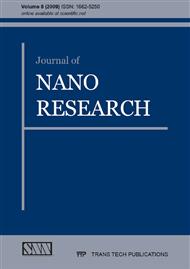[1]
K. Elert, C. Rodriguez-Navarro, E. Sebastian Pardo, E. Hansen and O. Cazalla: Studies in Conservation Vol. 47 (2002), p.62.
DOI: 10.2307/1506835
Google Scholar
[2]
D.R. Moorehead: Cement Concrete Res Vol. 16 (1986), p.700.
Google Scholar
[3]
J. Adams, W. Kneller and D. Dollimore: Thermochimica Acta Vol. 211 (1992), p.93.
Google Scholar
[4]
J. Elsen, A. Brutsaert, M. Deckers and R. Brulet: Mater Characterization Vol. 53 (2004), p.289.
Google Scholar
[5]
C. Sabbioni, G. Zappia, C. Riotino, M.T. Blanco-Varela, J. Aguilera, F. Puertas, K. Van Balen and E.E. Toumbakari: Atmos Environ Vol. 35 (2001), p.539.
Google Scholar
[6]
M. Santhanam, M.D. Cohen and J. Olek: Cement Concrete Res Vol. 33 (2003), p.341.
Google Scholar
[7]
I. Karatasios, V. Kilikoglou, P. Theoulakis, B. Colston and D. Watt: Cement Concrete Res Vol. 30 (2008), p.815.
DOI: 10.1016/j.cemconcomp.2008.06.010
Google Scholar
[8]
P. Baglioni and R. Giorgi: Soft Matter Vol. 2 (2006), p.293.
Google Scholar
[9]
I. Karatasios, V. Kilikoglou, B. Colston, P. Theoulakis and D. Watt: Cement Concrete Res Vol. 37 (2007), p.886.
DOI: 10.1016/j.cemconres.2007.03.007
Google Scholar
[10]
J. Moreda-Piñeiro, C. Moscoso-Pérez, M. Piñeiro-Iglesias, P. López-Mahía, S. MuniateguiLorenzo, E. Fernández-Fernández, D. Prada-Rodríguez: Atomic Spectroscopy Vol. 28 (2007), p.137.
DOI: 10.1016/j.aca.2004.09.046
Google Scholar
[11]
R. Varela Diaz: Contaminación atmosférica en Galiza: inventario de emisións de gases de efecto invernadoiro, gases acidificantes e dioxinas, ano 2000 (Baía A Coruña, Spain 2004).
Google Scholar
[12]
E. De Vedia y Gossens: Historia y descripción de la ciudad de La Coruña (Imprenta Domingo Puga, A Coruña, Spain 1845).
Google Scholar
[13]
S. Bruni, F. Cariati, P. Fermo, P. Cairati, G. Alessandrini and L. Toniolo: Archaeometry Vol. 39 (1997), p.1.
DOI: 10.1111/j.1475-4754.1997.tb00786.x
Google Scholar
[14]
J. Sanjurjo Sánchez, J.R. Vidal Romaní and C.A.S. Alves, in: 6th International Symposium on the Conservation of Monuments in the Mediterranean Basin, Lisbon (2004), p.202.
Google Scholar
[15]
J. Sanjurjo Sánchez, J.R. Vidal Romaní, D. Fernández-Mosquera and C.A.S. Alves: X-Ray Spectrom Vol. 37 (2008), p.346.
Google Scholar
[16]
R. I. Dorn: Rock Coatings (Elsevier, Amsterdam 1998).
Google Scholar
[17]
M. Del Monte and C. Sabbioni: Arch Meteorol Geophys Bioclimatol Vol. 35 (1984), p.105.
Google Scholar
[18]
A. Arnold and K. Zehnder, in: 1st International Symposium on the Conservation of Monuments in the Mediterranean Basin, Bari (1989), p.13.
Google Scholar
[19]
A. Chavas and D. Jeannette: Environ Geology, 40 Vol. (2001), p.359.
Google Scholar


